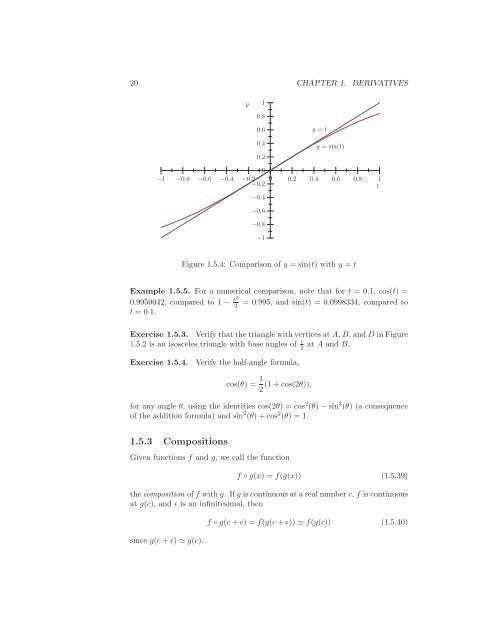Yet Another Calculus Text, 2007a
Yet Another Calculus Text, 2007a
Yet Another Calculus Text, 2007a
You also want an ePaper? Increase the reach of your titles
YUMPU automatically turns print PDFs into web optimized ePapers that Google loves.
20 CHAPTER 1. DERIVATIVES<br />
y<br />
1<br />
0.8<br />
0.6<br />
0.4<br />
0.2<br />
y = t<br />
y =sin(t)<br />
0<br />
−1 −0.8 −0.6 −0.4 −0.2 0 0.2 0.4 0.6 0.8 1<br />
−0.2<br />
t<br />
−0.4<br />
−0.6<br />
−0.8<br />
−1<br />
Figure 1.5.4: Comparison of y =sin(t) withy = t<br />
Example 1.5.5. For a numerical comparison, note that for t =0.1, cos(t) =<br />
0.9950042, compared to 1 − t2 2<br />
=0.995, and sin(t) =0.0998334, compared to<br />
t =0.1.<br />
Exercise 1.5.3. Verify that the triangle with vertices at A, B, andD in Figure<br />
1.5.2 is an isosceles triangle with base angles of t 2<br />
at A and B.<br />
Exercise 1.5.4.<br />
Verify the half-angle formula,<br />
cos(θ) = 1 (1 + cos(2θ)),<br />
2<br />
for any angle θ, using the identities cos(2θ) =cos 2 (θ) − sin 2 (θ) (a consequence<br />
of the addition formula) and sin 2 (θ)+cos 2 (θ) =1.<br />
1.5.3 Compositions<br />
Given functions f and g, wecallthefunction<br />
f ◦ g(x) =f(g(x)) (1.5.39)<br />
the composition of f with g. Ifg is continuous at a real number c, f is continuous<br />
at g(c), and ɛ is an infinitesimal, then<br />
since g(c + ɛ) ≃ g(c).<br />
f ◦ g(c + ɛ) =f(g(c + ɛ)) ≃ f(g(c)) (1.5.40)


















